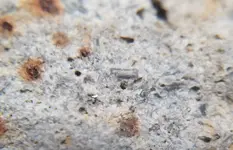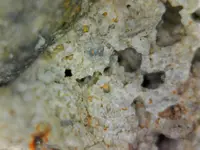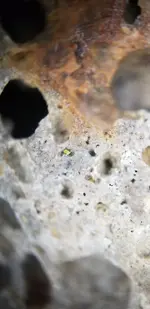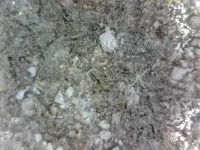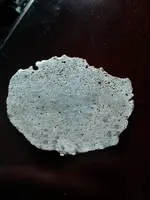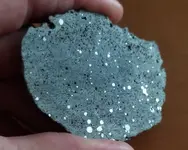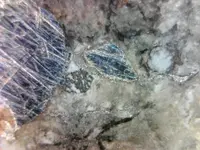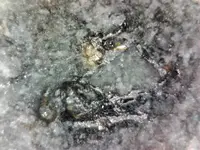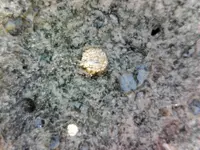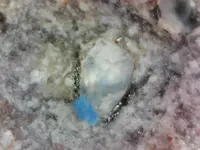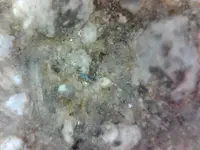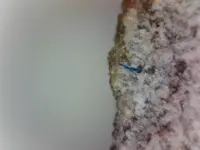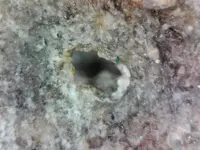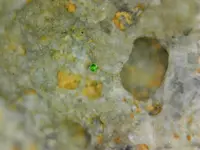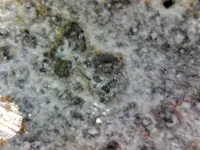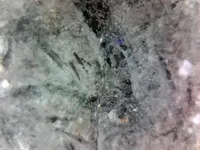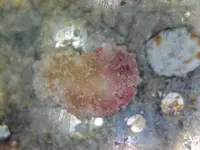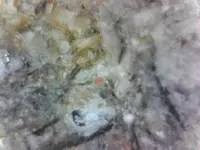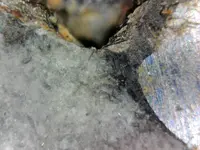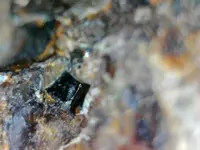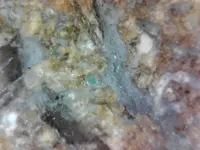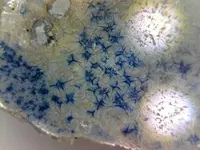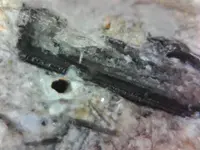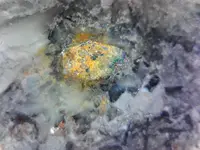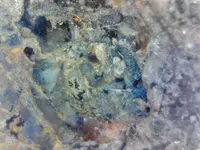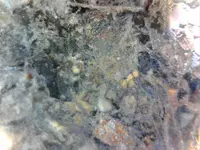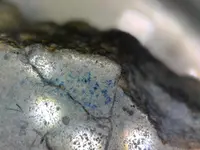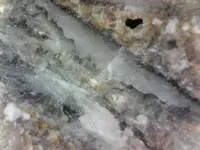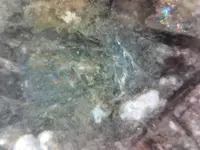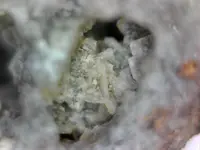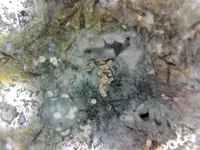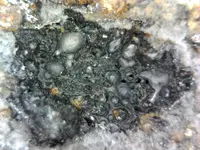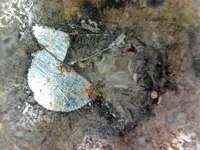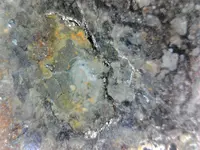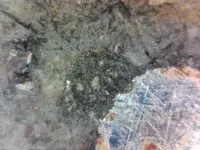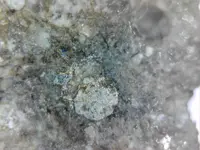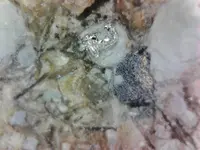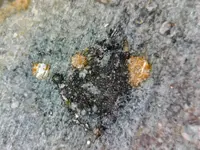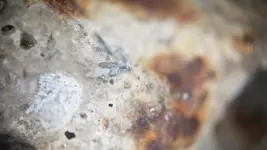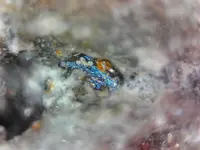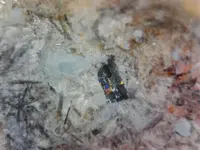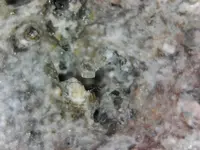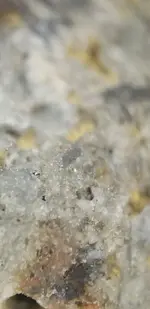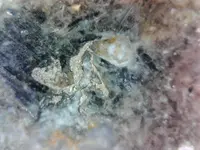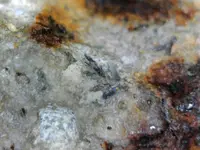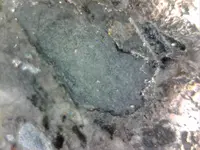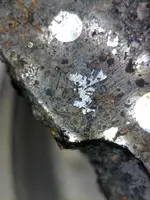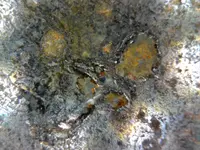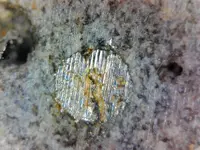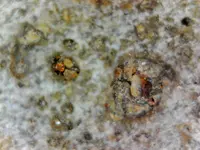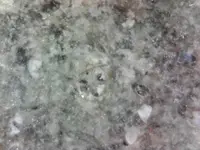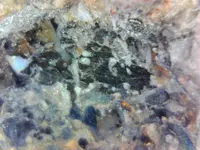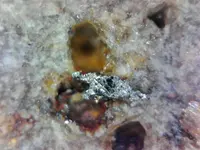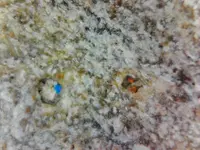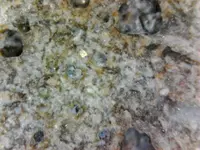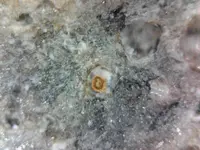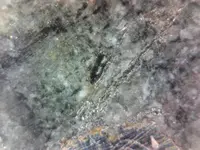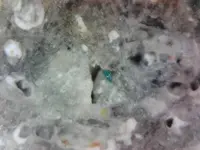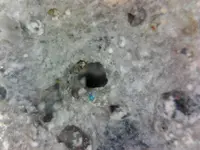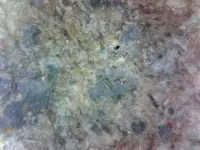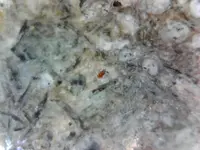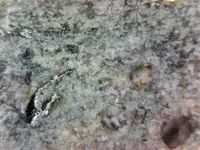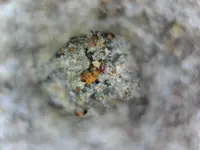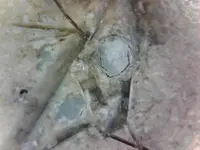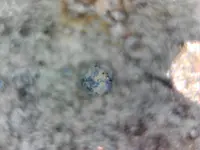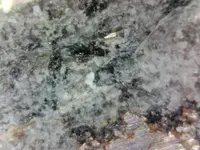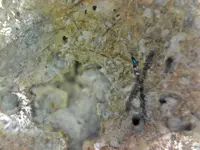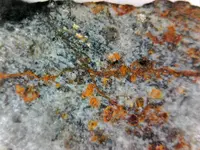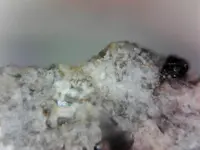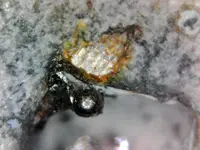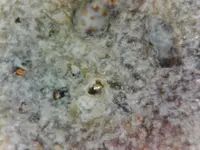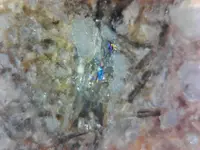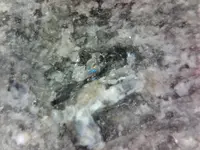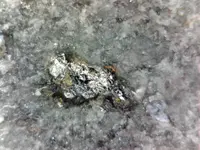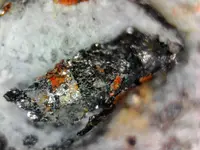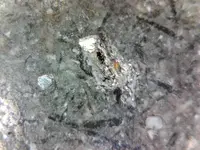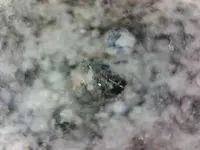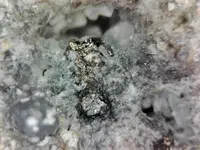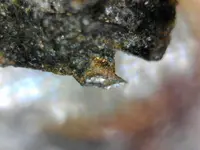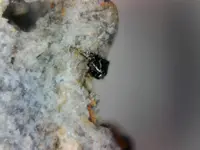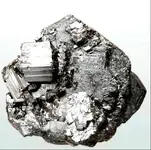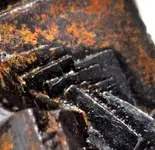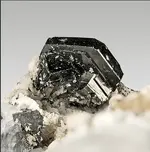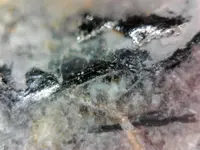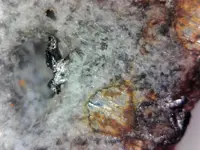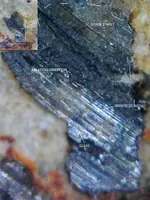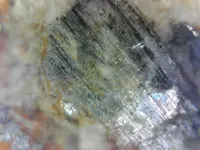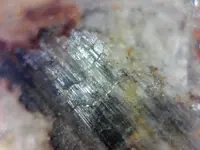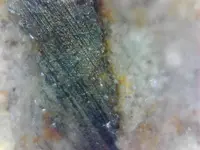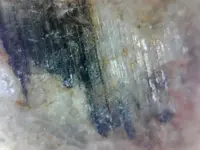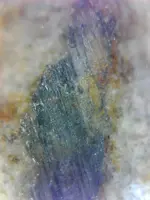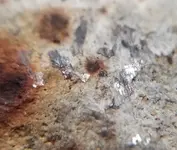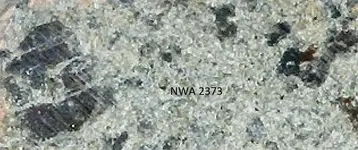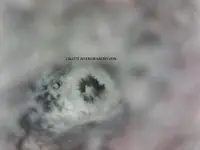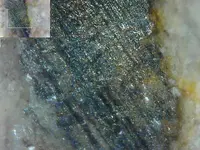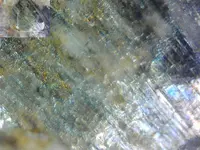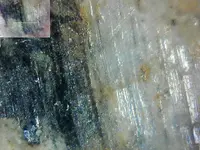Although I have already received a whole rock analysis, a second sample is on the way. I unfortunately had to send the second sample because I did not follow the directions, making sure the sample represents the whole of the rock. I purchased a used ten inch rock saw and a new blade to cut slabs getting me closer to the meat of the rock and away from the calcite filled exterior and other possible terrestrial contamination. There is still calcite in the interior but it appears minimal compared to the exterior. I used an x-y axis vice, covered in plastic with cedar shakes on the bottom and sides of the iron jaws to lock the rock in place, avoiding damage. This worked beautifully for making even slices. "How thick would you like your rock sliced sir"... my very own rock deli. My sample was skewed in more ways than one. The sample was from only the exterior of the rock, where most of the terrestrial contamination would be the greatest. Under 200x magnification, the calcite spikes are prominent in the micro voids on the edge, this can be seen with the naked eye as a whole, slightly off colored (wash) around the edge. The calcite spikes grew post heating event, these are so small you can barely focus on them with 200x. Additionally, while cutting the first set of slabs with a glass band saw, the stress fractures that ran between the metallic spherules and other features, caused the slab edge to break, leaving me with large metallic spherules and a bunch of them at that. These were all added to the first sample that I had sent and not a very good representation for whole rock analysis. This definitely skewed a very important Fe2o3 number. Lab numbers were still very good but not a winner in the recipe for meteorites that have been tested. Three things noted by Randy: The CaO came in at 23.79%, this is high but can be attributed to the calcite filled micro voids, it should be 18% or lower. The SiO2 is low at 27.92% but there are a few other meteorites that are even lower, hopefully the new sample will come back with better numbers. The other obstacle was the nickel, my sample was very low at under 20 PPM, again, hopefully the center mass sample comes back with better numbers. The reason I'm writing this now, instead of waiting for center mass results is because I've had a wonderful breakthrough researching the many 1mm to 3mm tiny shiny patches on the exterior of my find. These little islands of glass are heavily micro striated in dark, clear and opaque colors. On an angle they are very reflective, like glass, little silver surfers found scattered on all sides. Using sunlight or a flashlight and tilting it on an angle can make them stand right out. I was trying to find any rocks from glacial to meteoric that had these striations. This is when I found a 3 to 4 gram meteorite from Mars on the internet that had almost identical very distinct micro striations. The meteorite is Northwest Africa 2373. The bulletin reads: "They are yellow brown with desert ablation/varnish surface only, no fusion crust"... okay, here we go. What does a meteorite from Mars found in Morocco have in common with a rock from New Jersey? Micro striations caused by dessert ablation on a rock varnish, so I thought. I found that the glaciers terminated here in South Jersey as well as in Morocco and ran with it. Studying and searching for the different ablation zones in glaciers and the types of ablation scars on the micro level was necessary to make a determination. I felt like if this was caused by sand particulates then this rock would have been carried in a slip towards the end of the glacier where the abrasion zone would be. A slip is the faster moving upper level of a glacier. No (micro) pictures of this type of ablation to be found, but plenty of large scale ablation on bedrock. I had purchased a 200x Opti-Tek scope to look at the interior of my find, I used it to get better pictures of my little striated silver surfers. My previous pictures were at 25x and that's when my breakthrough happened. The first picture was at 200x, a closeup of the striations on a 1mm x .5 mm area that was pitch black while looking right at it. I was all about the striations and looking at the grooves, trying to determine what caused them. I measured one of the lands, I'm comparing these striations to rifling in a muzzle (that's what the grooves reminded me of). Lands are the high point, grooves are the low point (definitely flow lines). Since my scope is taking pictures at the same resolution as that of my monitor, I measured a few lands and found that they were around 1/64 of an inch wide on the monitor. This divided by 200 = .000078125 (bushman measurement). At this point it had dawned on me, I had been firing, fusing, sandblasting and carving ornamental glass for over 40 years and even with a screened out 5 micron abrasive and a micro blaster this feet would be impossible to duplicate on a surface full of convex and concave undulations. You wouldn't have a nozzle small enough, resist used for sand blasting never mind a media for blasting. The glass lands were rolled together and perfectly rounded so this is definitely a melt. The glass is very reflective, if blasted, it would be at its best, dull. Sand ablation will and could not cause these micro striations. The sands in a dessert are dust particulates to a full grain, wind going in one direction (maybe) as the carrier would eventually pick up all sizes of abrasive and wear the surface smooth, not cut micro grooves. Sand is not the purveyor of these micro striations. I started taking more pictures of these striations and that's when I realized that all of the striations about 60 of them were all oriented pointing to one place (oriented they are). I went back to my original 200x picture and looked at the grooves. Some were straight and some had a slight radius and changed with the topography of the exterior and they varied from wide to small. I thought at this point these were definitely made by a high pressure airflow on a molten surface. My theory is that this one was moving faster or possibly had a longer hotter burn. I zoomed into the darker areas and that's when I stood up out of my chair cursing like a pirate. Behind the glass flow lines was glorious, beautiful, second stage melt and WOW... No varnish here whatsoever just melt. As far as the Northwest Africa 2373, I'm sure it had dessert ablation, having been found in the desert but the sand did not cause those micro lines. It could possibly be a crust with melt ablation and flow lines. I will be posting the analysis from both the first set of whole rock numbers I received and the second set of numbers when they arrive, together on graphs for comparison. Any questions feel free to ask. Any collectors out there with these types of a micro flow lines in your collection please post pictures.



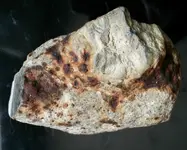
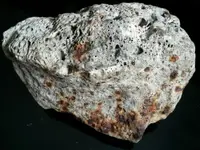
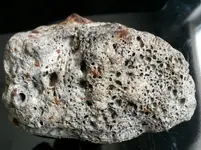
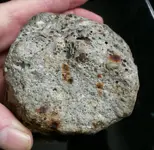
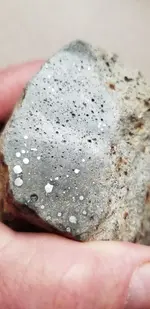
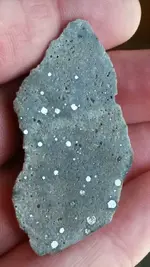
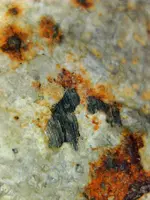
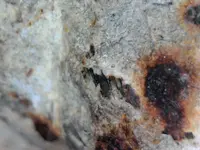
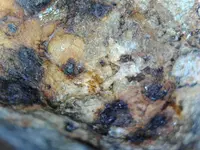
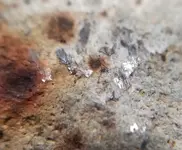
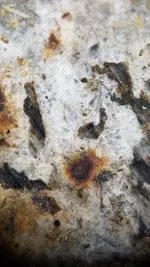
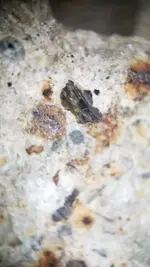
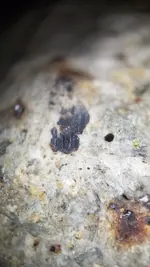
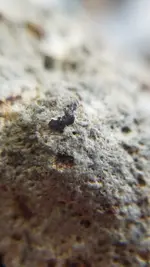
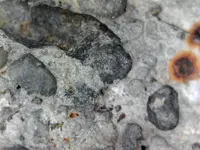
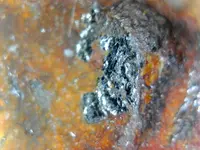
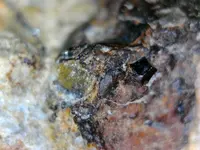
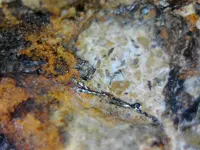
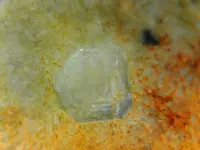
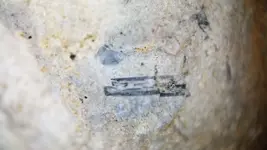
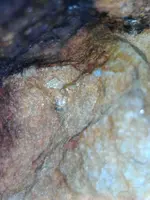
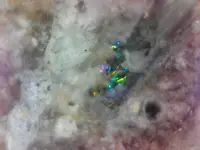
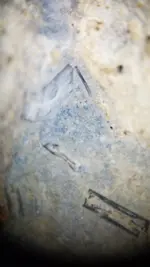
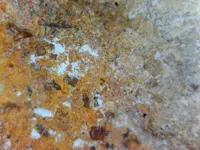
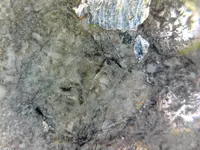
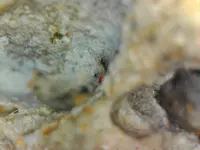

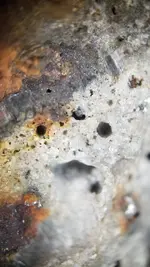
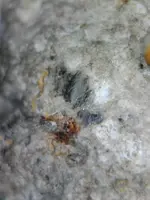
 ). I guess there truly is a sucker born every minute I just have to get it tested, off it goes. Who is the best? Please let me know. Its a win win situation, I will get to know for sure and at the same time I get to support the hard working Americans in the lab. This has truly been a gift tripping over this sucker in the sand pile in my backyard, I almost face planted. I haven't stopped reading and learning and looking at this melted rock for many, many days. No matter the outcome I have a new appreciation for rocks from everywhere now. Its been a great read and a wonderful learning lesson.
). I guess there truly is a sucker born every minute I just have to get it tested, off it goes. Who is the best? Please let me know. Its a win win situation, I will get to know for sure and at the same time I get to support the hard working Americans in the lab. This has truly been a gift tripping over this sucker in the sand pile in my backyard, I almost face planted. I haven't stopped reading and learning and looking at this melted rock for many, many days. No matter the outcome I have a new appreciation for rocks from everywhere now. Its been a great read and a wonderful learning lesson.